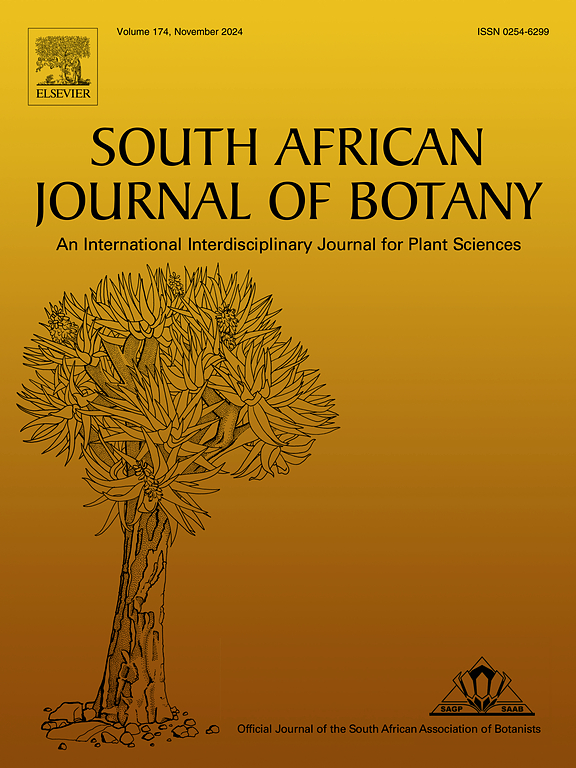Ethnobotanical survey of traditional knowledge and food practices of traditional leafy vegetables consumed within the Bronkhorstspruit, Gauteng province, South Africa
IF 2.7
3区 生物学
Q2 PLANT SCIENCES
引用次数: 0
Abstract
The United Nations has created the Sustainable Development Goals (SDGs) intending to eliminate poverty and ensure healthy lives and wellbeing. The current study aims to work towards achieving goal number three, which promotes good health and well-being. Traditional leafy vegetables (TLVs) forms part of most traditional communities and plays a vital role in daily diets. Traditional knowledge (TK) on the use and practices is however being lost and this could impact on the food security and health of communities. TLVs remain underutilised, undervalued and neglected crops. The aim of this study was to investigate the popularity, uses, household cooking techniques and recipes of traditional leafy vegetables locally available in the study area, Bronkhorstspruit. Data was gathered among different cultural groups using questionnaires, in-depth interviews and focus groups. Three hundred (300) female participants from different age and cultural groups were interviewed. The relative frequency of citation (RFC), use value (UV), use report (UR) and cooking techniques of locally consumed traditional leafy vegetables (TLVs) were determined. Results indicated that 75 % of the 20 identified traditional leafy vegetables had an RFC of 80–95 %, suggesting their high popularity in the area. In addition, 20 TLVs per cultural group belonging to 10 families, with species belonging to the Cucurbitaceae family, which was the dominant family utilized, Amaranthus spinosus, Cleome and Cucurbita species, being the most popular, with RFC values between 90 and 95 % per cultural group. Momordica balsamina had the highest use reports (UR) and use value (UV) of 0.242 compared to other TLVs. Traditional recipes differed per cultural group. Most participants indicated boiling as the most preferred household cooking technique for TLVs. The current study highlighted the rich ethnobotanical knowledge and diverse culinary practices surrounding traditional leafy vegetables in Bronkhorstspruit, underscoring their cultural significance, nutritional value, and potential role in promoting sustainable food systems and preserving indigenous knowledge in South Africa.
南非豪登省Bronkhorstspruit地区消费的传统叶类蔬菜的传统知识和饮食习惯的民族植物学调查
联合国制定了可持续发展目标(sdg),旨在消除贫困,确保健康的生活和福祉。目前的研究旨在实现第三个目标,即促进身体健康和幸福。传统叶菜(TLVs)是大多数传统社区的一部分,在日常饮食中起着至关重要的作用。然而,关于使用和做法的传统知识正在流失,这可能会影响社区的粮食安全和健康。tlv作物仍未得到充分利用、被低估和被忽视。这项研究的目的是调查研究地区当地传统叶菜Bronkhorstspruit的流行程度、用途、家庭烹饪技术和食谱。通过问卷调查、深度访谈和焦点小组,在不同文化群体中收集数据。来自不同年龄和文化群体的300名女性参与者接受了采访。测定了当地传统叶菜的相对被引频次(RFC)、使用价值(UV)、使用报告(UR)和烹饪技术。结果表明,在20种经鉴定的传统叶菜中,75%的RFC为80 - 95%,表明它们在该地区非常受欢迎。每个培养群有20个tlv,隶属于10科,其中以葫芦科植物为优势科,以苋属(Amaranthus spinosus)、山楂属(Cleome)和葫芦属(Cucurbita)最受欢迎,每个培养群的RFC值在90 ~ 95%之间。与其他tlv相比,苦瓜的使用报告(UR)和使用值(UV)最高,为0.242。不同文化群体的传统食谱各不相同。大多数参与者表示,煮是最受欢迎的家庭烹饪技术。目前的研究强调了丰富的民族植物学知识和围绕Bronkhorstspruit传统叶菜的多样化烹饪实践,强调了它们的文化意义、营养价值以及在促进南非可持续粮食系统和保护土著知识方面的潜在作用。
本文章由计算机程序翻译,如有差异,请以英文原文为准。
求助全文
约1分钟内获得全文
求助全文
来源期刊

South African Journal of Botany
生物-植物科学
CiteScore
5.20
自引率
9.70%
发文量
709
审稿时长
61 days
期刊介绍:
The South African Journal of Botany publishes original papers that deal with the classification, biodiversity, morphology, physiology, molecular biology, ecology, biotechnology, ethnobotany and other botanically related aspects of species that are of importance to southern Africa. Manuscripts dealing with significant new findings on other species of the world and general botanical principles will also be considered and are encouraged.
 求助内容:
求助内容: 应助结果提醒方式:
应助结果提醒方式:


